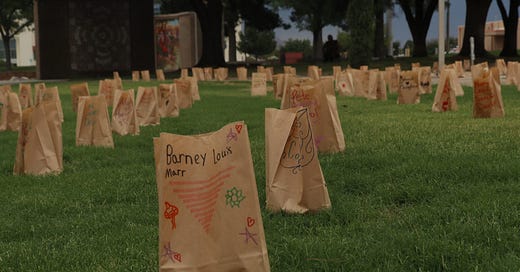For Downwinders, Oppenheimer is more than a movie.

I haven’t seen Oppenheimer yet.
I will wait until it is streaming. For me the sound quality in movie theaters doesn’t work well with my hearing aids. So, until there is open captioning I can wait.
But I have been following the conversation and the new attention being paid to Downwinders.
Downwinders is a term used to describe those who lived within range of the immediate fallout from the above ground testing of Oppenheimer’s atom bomb.
However, in one respect the entire globe is a Downwinder from above-ground nuclear testing which continued until the sixties - even after the test ban treaty - by the United States, the Soviet Union and France.
Nuclear fallout spread around the planet, likely causing the death of tens of thousands if not more.
In a rare public admission, a story appeared in the Los Angeles Times in 1994 about a nuclear cloud that hung over the Los Angeles basin for a week in 1964.
“Low levels of radiation,” the government said. But shortly thereafter my mother was diagnosed with Hodgkins, a form of leukemia. It killed her in 1977.
Given the government secrecy related to health issues resulting from nuclear testing, the claim of low levels of radiation from the nuclear cloud and other fallout should be taken with a large dose of suspicion.
Lit by the glow of hundreds of luminarias at dusk, a group gathered recently in Robinson Park, Las Cruces to hear the list of more than 800 names of the dead read aloud.
This is the ongoing legacy of nuclear testing.
For example there are the people who have died of cancer around the Tularosa Basin since 1945, when the first atomic bomb “Trinity” detonated across the deserts of Southern New Mexico.
Despite the government’s continued description of the Jornada del Muerto test site as “isolated,” and “remote” in archives, tens of thousands of people lived within 50 miles of the first nuclear blast. These people, and their descendants were marked by diseases without family histories – including leukemia and other cancers.
Downwinders in New Mexico are still seeking justice after the federal government’s exposure of citizens to nuclear fallout 78 years ago.
The Tularosa Basin Downwinders Consortium, founded in 2005, is a group lobbying for people living in Carrizozo, Tularosa, Socorro, and other places touched by the first atomic bomb.
The federal government has a program that offers both an apology and monetary compensation for people sickened by diseases from radiation exposure. The Radiation Exposure Compensation Act (RECA), passed in 1990, came after decades of above-ground testing in the American West and Pacific Islands.
RECA is a unique fund, paying out one-time benefit payments. It requires people establish they have a diagnosis of listed diseases after working or living in designated irradiated locations over specific periods of time.
Currently, only uranium miners, millers, transporters, people who worked on weapons test sites and people who lived in specific Utah, Arizona and Nevada counties downwind of test sites are eligible.
Covered cancers for Downwinders include certain bone cancers, plasma cancer and lymphatic cancers. Also included are primary cancers of the throat, thyroid, gall bladder, colon, small intestine, lung, brain, stomach, bladder, ovaries, pancreas, breasts, or liver.
Families can collect compensation on behalf of a deceased relative.
But an effort to amend the RECA failed in 2022.
However, Congress did vote to extend the program until 2024, giving a small reprieve to lawmakers trying to expand the program.
In early July, Sen. Ben Ray Luján and Idaho Republican Sen. Mike Crapo, along with Rep. Teresa Leger Fernández put forward legislation in both houses to amend RECA again.
The bill would recognize Downwinders in additional states, expand some of the covered conditions, and extend the life of the fund by another 20 years.
All five of New Mexico’s delegation to Congress strongly support the bill.
But lawmakers in both houses, both Democrats and Republicans, have balked at expanding RECA.
In three decades, RECA has paid out $2.6 billion dollars to more than 40,000 people.
That’s a fraction of a percent of the $634 billion the federal government plans to spend on nuclear weapons and development in the next decade, according to estimates from the Congressional Budget Office.



